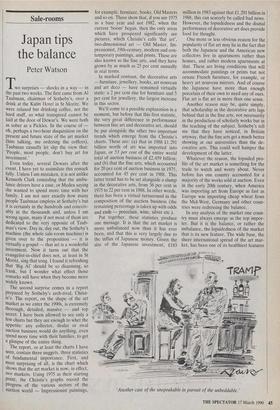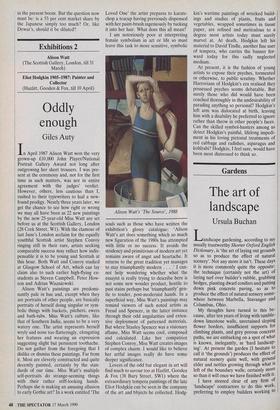Sale-rooms
Japan tips the balance
Peter Watson
Two surprises — shocks in a way — in the past two weeks. The first came from.Al Taubman, chairman of Sotheby's, over a drink at the Kuim Hotel in St Moritz. We were relaxed but drinking coffee, not the hard stuff, so what transpired cannot be laid at the door of Dewar's. We were both as sober as a Pickles. In the course of oh, perhaps a two-hour disquisition on the present and future state of the art market (him talking, me ordering the coffees), Taubman casually let slip the view that: `People, most people, don't buy art for investment.'
Even today, several Dewars after the event, I have yet to assimilate this remark fully. Unless I am mistaken, it is not unlike Kenneth Clark conceding that the ambu- lance drivers have a case, or Medea saying she wanted to spend more time with her family. I am not sure exactly how many people Taubman employs at Sotheby's but it is certainly in the hundreds and conceiv- ably in the thousands and, unless I am wrong again, many if not most of theni are dedicated to the very opposite of Taub- man's view. Day in, day out, the Sotheby's machine (the whole sale-room machine) is given over to the proposition -- it is virtually a gospel — that art is a wonderful investment. Now it turns out that the evangelist-in-chief does not, at least in St Moritz, sing that song. I found it refreshing that 'Big Al' should be so disarming, so frank, but I wonder what effect those remarks will have when they become more widely known.
The second surprise comes in a report prepared by Sotheby's arch-rival, Christ- ie's. The report, on the shape of the art market as we enter the 1990s, is extremely thorough, detailed, massive — and top secret. I have been allowed to see only a few charts but they are enough to whet the appetite: any collector, dealer or rival auction business would do anything, even spend more time with their families, to get a glimpse of the entire thing.
The report, or at least the charts I have seen, contain three nuggets, three statistics of fundamental importance. First, and most surprising of all, is the chart which shows that the art market is now, in effect, two markets. Using 1975 as their starting Point, the Christie's graphs record the progress of the various sectors of the auction world — Impressionist paintings, for example, furniture, books, Old Masters and so on. These show that, if you use 1975 as a base year and not 1982, when the current 'boom' began, then the only areas which have prospered significantly are pictures, which Christie's calls 'flat art', two-dimensional art — Old Master, Im- pressionist, 19th-century, modern and con- temporary paintings, and prints. These are also known as the fine arts, and they have grown by as much as 25 per cent annually in real terms.
In marked contrast, the decorative arts — furniture, jewellery, books, art nouveau and art deco — have remained virtually static: a 2 per cent rise for furniture and 5 per cent for jewellery, the largest increase in this sector.
We'll come to a possible explanation in a moment, but before that this first statistic, the very great difference in performance between fine art and decorative art, should be put alongside the other two important trends which emerge from the Christie's charts. These are: (a) that in 1988 £1.291 billion worth of art was imported into Japan, or .53 per cent of the entire world total of auction business of £2.459 billion; and (b) that the fine arts, which accounted for 20 per cent of auction business in 1975, accounted for 45 per cent in 1988. This latter trend has to be set alongside a slump in the decorative arts, from 36 per cent in 1975 to 22 per cent in 1988. In other words, there has been a virtual turnaround in the composition of the auction business (the remaining percentage is taken up with odds and ends — porcelain, wine, silver etc.).
Put together, these statistics produce one message. It is that the art market is more unbalanced now than it has ever been, and that this is very largely due to the influx of Japanese money. Given the size of the Japanese investment, £183 million in 1983 against that £1.291 billion in 1988, this can scarcely be called bad news. However, the lopsidedness and the dismal performance of decorative art does provide food for thought.
One more or less obvious reason for the popularity of flat art may lie in the fact that both the Japanese and the American new collectors live in apartments rather than houses, and rather modern apartments at that. These are living conditions that will accommodate paintings or prints but not ornate French furniture, for example, or heavy art nouveau mirrors. And of course the Japanese have more than enough porcelain of their own to need any of ours. Flat art is flat art in more than one sense.
Another reason may be, quite simply, that scholarship in the decorative arts lags behind that in the fine arts, not necessarily in the production of scholarly works but in the teaching of the subject. Sotheby's tell me that they have noticed, in Britain anyway, that the fine arts get a much better showing at our universities than the de- corative arts. This could well hamper the development of the latter.
Whatever the reason, the lopsided pro- file of the art market is something for the trade to watch and worry about. Never before has one country accounted for a majority of the works sold at auction. Even in the early 20th century, when America was importing art from Europe as fast as Europe was importing cheap wheat from the Mid-West, Germany and other coun- tries were redressing the balance.
In any analysis of the market one coun- try must always emerge as the top impor- ter. But it is the balance, or rather the imbalance, the lopsidedness of the market that is its new feature. The wide base, the sheer international spread of the art mar- ket, has been one of its healthiest features `Another case of the unspeakable in pursuit of the unbeddable.' in the present boom. But the question now must be: is a 53 per cent market share by the Japanese simply too much? Or, like Dewar's, shoidd it be diluted?



























































 Previous page
Previous page